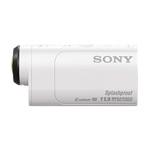Last week I purchased a new camera for recording videos on YouTube. Rather than buy a traditional point and shoot camera or camcorder, I opted for an action camera.
I have only been using the camera a short period of time, however I am happy with the purchase. It is such a tiny little device, which means that I can easily take the camera with me at all times and film something whenever I feel the need to do so.
In this article, I would like to explain my reasoning for purchasing the camera and the reason I have started using Adobe Premiere Pro CC to edit my videos.
Before I do so, I would like to share with you a series of videos I have published on YouTube that showcase the Sony Action Cam (HDR-AZ1) and Live-View Remote Kit (RM-LVR2V).
The first video I published was an unboxing. This video shows you exactly what you can expect to see when you purchase the Sony HDR-AZ1.
In my second video, I show you how to use the camera and live-view remote kit. This will give you a good understanding of how the camera works in practice.
In my third video, I recorded clips using the camera on a day out in Bogota and Sopo (a small town North of Bogota).
I tested a variety of situations including inside, outside with noisy traffic, on a bus, and in a low-light situation (or to be more exact – pitch black). At the end of the video, I give my opinion on the camera after using it for four days.
I hope you enjoyed the above videos. If you would like to know more about why I purchased the camera, and hear about my YouTube journey over the last few weeks, please read on.
The Longer Story About Why I Purchased a Sony Action Cam
I still consider myself a beginner when it comes to recording videos for YouTube. However, I am doing my utmost to learn more every week and improve the quality of videos I am publishing.
One common piece of advice to new YouTubers is to simply start with what equipment you have at your disposal, be it your smartphone, budget camera, screencast recording software, or whatever. I think this is great advice as I truly believe the best way to become more competent at recording and editing videos is to jump right in there. It is kind of like riding a bike. You wouldn’t learn how to ride a bike by reading a book, would you?
I followed this advice when I started recording videos more than two years ago. I initially recorded videos while travelling South America using the Olympus PEN E-PL1. Shortly afterwards, I recorded screencasts using Screencast-O-Matic.
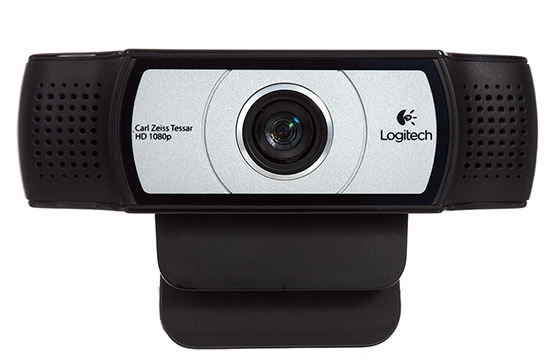
A few months ago I purchased the Logitech c930e for recording YouTube videos. It is capable of recording 1080p videos at 30 frames per second. I have also used my HTC One M8 to record a couple of videos. That can record at 1080p at 30 frames per second too, though that smartphone lacks image stabilisation and the audio quality is not great.
What became clear to me over the last few months, even as a beginner, is that the equipment and software you use for recording videos can greatly influence the quality of your final product.
In the end, I decided to buy a Sony Action Camera for recording videos, but I still plan on purchasing a better video camera in month or two.
Choosing the Right Video Editor
I touched upon the issues I have been facing in a recent video. Two of the things that I felt I needed to move forward with YouTube were:
- A better camera for recording vlogs and other videos
- A good video editing solution
The video quality from my Logitech webcam is ok, but is nothing spectacular. However, the main thing that concerned me was how limiting it is to use a webcam to record videos since I always have to be connected to my computer.
I wanted a portable camera that I could quickly use at any time, whether I was in the house, on a bus, or out in the streets.
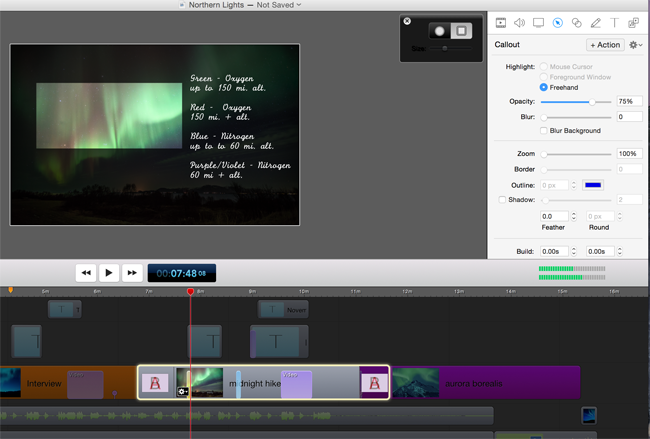
Video editing became a concern for me when I left the UK. At home I had been using ScreenFlow to record videos on my 27″ iMac. However, I use my Windows 7 powered Lenovo X220 laptop whilst travelling. Unfortunately, ScreenFlow has yet to be released for Windows (and the developers are quiet about a Windows release they once teased). Therefore, when I made the decision to come to South America two weeks, I inadvertently put myself in a position of having to find a good video editing solution for Windows.
My last video was edited using VideoPad. The program is free to download, though I was not really pleased with the way it worked. It is a little rough around the edges, but my main concern was that it only allowed me to record videos through my webcam at 1080p at 5 frames per second; despite the fact the webcam supports 30 frames per second. Other free programs I downloaded and budget (less than $100) video editing programs I trialled were limiting in other ways.
I noted last week that I was reluctant to purchase a more premium product such as Sony Vegas Pro or Adobe Premiere Pro CC since I will likely return to editing videos with ScreenFlow when I return to the UK in May. It didn’t feel like the right move to purchase an expensive video editing program at this time, especially since I still haven’t learned everything that ScreenFlow has to offer.
I soon did a U-turn and realised that this was the wrong way of thinking about this issue, since Adobe allow users to purchase Adobe Premiere Pro CC on a monthly plan. And that is exactly what I did. I signed up to use Adobe Premiere Pro CC on a monthly basis.
Ironically, Premiere Pro CC does not support video capturing with my Logitech webcam. So in order to record the unboxing and explanation videos of my new action camera, I had to record at 720p using Screencast-O-Matic and then upscale the videos to 1080p. Not a great solution, but it should hopefully be the last time I have to do that.
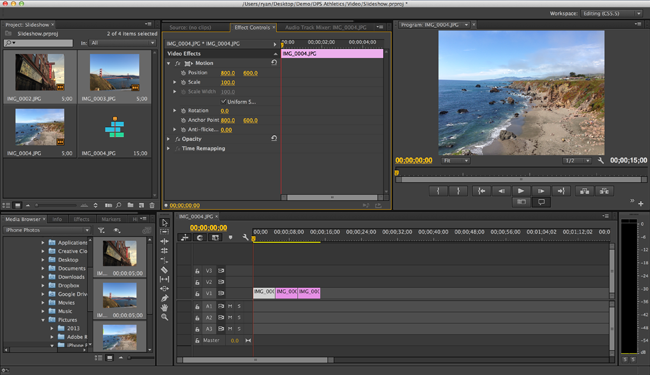
Adobe Premiere Pro CC is regarded by many as the best video editing application available online, so I always assumed I would migrate to it at one point in the future. My concern was that I was not experienced enough to take advantage of everything it offers.
I will use the software for the next two months. That will give me enough time to determine whether I should continue paying for Adobe Premiere Pro CC, or whether ScreenFlow is more than sufficient for what I am doing online.
My Search for the Right Camera for YouTube Videos
I suspect that within the next two years, most high-end smartphones will be good enough for recording videos for YouTube. Currently, most good smartphones can record in full HD. Some new smartphones can even record in 4K. The area they all seem to be lacking at the moment is good audio.
My initial thought was to buy an affordable camera that could record in full HD. Two that I was considering here in Colombia were the Samsung NX Mini and Sony DSC-WX350.
The Samsing NX Mini is available in Colombia for around £160. It can record in 1080p at 30 frames per second, though is limited by a mono microphone. The Sony DSC-WX350 is available for approximately £135 in Colombia. It has a stereo microphone and can record in 1080p at 60 frames per second.
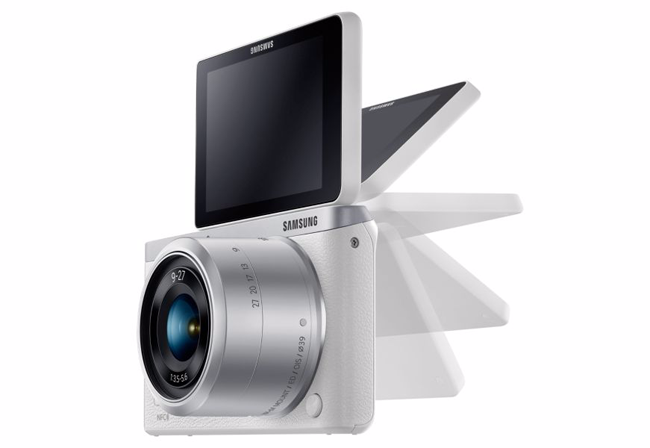
Neither camera has an external microphone, which is not a big concern for me at the moment since I will rely on the internal microphone of any camera or camcorder I buy. Both of these cameras are popular with YouTubers and I was impressed with the quality of videos they can produce (there are lots of test videos on YouTube).
Though I was a little hesitant to purchase either of these cameras as:
- I know that at some point over the next few months, I would feel the urge to upgrade to a better solution.
- If I purchase a new smartphone later in the year, the video/audio quality may be similar; which would make those cameras redundant
The better solutions I am referring to above are the Sony RX100 Mark II, Sony RX100 Mark III, and the Canon G7 X. The quality of videos these cameras produce is amazing and both can easily fit in your front jeans pocket.
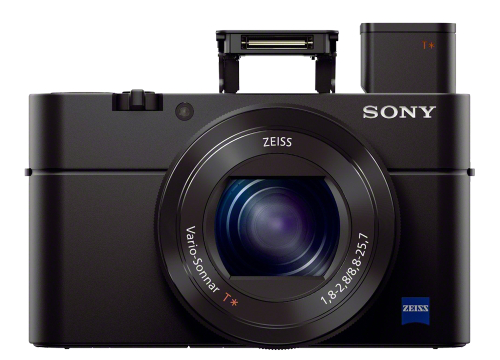
I have been unable to find the Canon G7 X in Colombia, however I was able to see the Sony RX100 Mark II up close last Saturday and I was incredibly impressed with how compact it was.
My eyes soon turned to the Sony action cameras on sale. For a few weeks, the Sony AS100V action camera was at the of my shopping list, but I had been unable to find it in Colombia. The camera is portable, is capable of recording full HD videos at high frame rates, and boasts an external microphone. The external microphone is simply a bonus as the camera has stereo microphones on the front that are capable of recording good audio (much better than its main competitor the GoPro).
I made the decision to purchase a Sony action camera in Colombia. My initial thought was to purchase a more capable video recording camera, such as the Sony RX100 Mark II, Sony RX100 Mark III, or Canon G7 X, when I return to Scotland. However, I have noticed a price drop of the Sony RX100 Mark II. The sale only lasts two more days and I have yet to find one in store, but if I can find one in stock, I will pick it up in Colombia.
I do not feel threatened walking around in Bogota. 99.9% of people living here are great, but I am acutely aware that there is a lot of poverty and crime in the city. I therefore do not feel comfortable walking around with an expensive camera speaking a foreign language as it draws attention to me and makes me a target. The Sony action cameras, however, are small enough to be hidden in my hand.
My purchase supports my plan not to buy a camera that I would not have to sell on a few months later. For example, even though I will now use my webcam less, I can continue to use the Logitech c930e over the next few years for live streaming and as a webcam for clients, friends, and family. And when I upgrade to a more powerful video recording solution over the next month, I will still actively use the Sony HDR AZ1 to record videos due to its portability and versatility. It will make a great camera for recording videos in my car or while hill walking etc.
One thing that became clear to me this week is that there are many situations in which two cameras are necessary for recording on YouTube. Sadly, the Logitech c930e is not suitable for a second camera. I encountered a huge amount of problems while recording with the webcam this week.
From a software point of view, I have yet to find a Windows application that allows me to record from the webcam in the 1080p/30fps recording that the device is capable of.
A bigger problem is the hardware itself. I lost hours of my time due to footage that could not be used. One of the biggest problems was that of video and audio not syncing. This ruined a couple of 15+ minute takes that had no mistakes in them. As a result of this issue, I had to start all over again since I looked like I was in a badly dubbed foreign film.
The problem with recording footage from a webcam is that everything needs to go through your computer. This presents a number of obstacles that can get in the way. Such as CPU spikes, RAM issues, software issues, encoding/conversion issues etc. A webcam is a good way of starting on YouTube and is ok for recording live streams, but ideally, you should record using a camera or camcorder instead.
The Sony HDR AZ1 Action Camera
I was all set to buy the Sony HDR AS100V, but one look at the Sony HDR AZ1 changed my mind.
The AZ1 is the smaller sibling of the AS100V. It can only record 11.9 megapixel photos instead of 13.5 megapixel, which is not a problem as I do not plan on using it for taking photographs.
Both cameras have similar video recording settings. They both can record 720p videos at 120 frames per second, though the larger AS100V can also record 240 frames per second at 480 x 240 pixels. Again, since I will primary be using the camera for recording videos for YouTube, the lack of an additional slow motion recording setting was not important to me.
What the AZ1 does lack is the external microphone, composite video, and HDMI out options, that the larger AS100V has. It also has a smaller battery, and therefore a shorter battery life, and a tiny LCD screen that only shows you battery life and whether wi-fi is on or off.
So why pick the AZ1?
Well, it is smaller. Much smaller. Apparently the camera is 35% smaller and 30% lighter, but when you look at the cameras side by side in a shop, the Sony HDR AZ1 looks about half the size. And the AZ1 still has great video recording capabilities and great audio since it uses the same stereo microphones (Dave from Geekanoids published a video test of the AS100V that convinced me of the audio quality of the device – thanks Dave).
For me, the added portability is a huge plus since it makes it easier for me to take the camera with me wherever I go.
Take a look at the photographs below that were taken by Pinbike in their review of the Sony HDR AZ1. They highlight the difference in size between the two cameras.
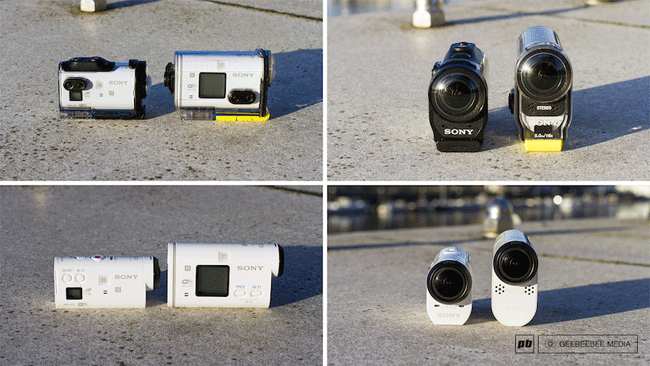
As per Sony’s website, here are the features of the Sony HDR AZ1:
- Sony’s smallest splash-proof Action Cam
- SteadyShot™ image stabilization conquers bumps and blur
- Control Action Cam via phone1 or up to 5 w/ Live-View Remote5
- 5 video modes (1080/60p and 2x slow motion)
- Built-In stereo mic for quality sound recording
- Broadcast your video live via Ustream as it happens
- Ultra wide up to 170° pro quality ZEISS® lens
- Exmor R® CMOS sensor for excellent low light performance
- Capture amazing high quality 11.9MP still images in photo mode
- Ruggedized, waterproof housing2 with universal tripod mount included
It’s an impressive feature list for such a small device. The ability to use it to stream on Ustream is an added bonus and the bundled live view remote comes packaged with the camera.
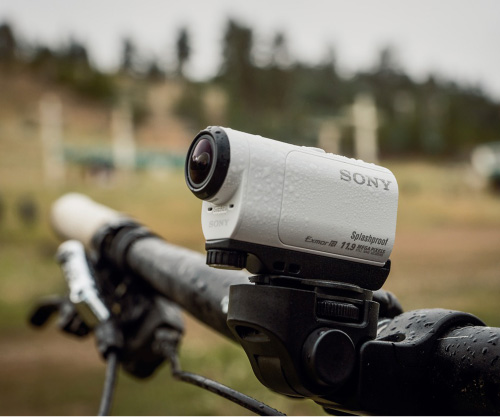
I hope you enjoyed this look at the Sony HDR AZ1. If you have any questions about the camera, please let me know and I will do my best to answer them.
And if you would like to start recording on YouTube yourself, please drop by Rise Forums, as I would love to connect with more internet marketers who are getting involved with video recording :)
Thanks,
Kevin

